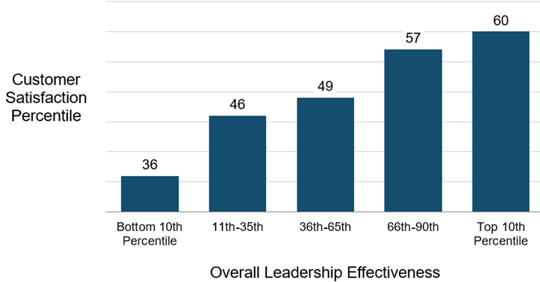
It’s been 60 years since Bob Dylan wrote his iconic song, The Times They Are a-Changin’, heralding the massive societal shifts about to rock the 1960s. We could apply these lines to today’s organizations:
Your old road is rapidly agin’
Please get out of the new one
If you can’t lend your hand
For the times they are a-changin’
Finding and keeping delighted customers and good people is a clarion call for leaders to lead, follow, or get out of the way. The balance of power and choice is a-changin’ to customers and frontline servers. These changing times demand changing leadership and organizational paradigms.
The word “paradigm” comes from the Greek for “pattern.” We use patterns every day to make sense of the world around us. Our traffic paradigm helps us recognize the pattern of cars buzzing around on our streets and enables us to reach our destination safely. Our gravity paradigm keeps us from stepping off tall buildings. Established paradigms keep us from having to constantly test and make up new guidelines for a wide variety of routine activities. But paradigm paralysis can limit our thinking and trap us into old patterns that no longer fit new circumstances.
Voluntarism: External Service = Internal Service
The old paradigm of manipulating (often called “motivating”) frontline servers to increase customer satisfaction by pushing with incentives, recognition programs, and other bribes is rapidly agin’ — and losing effectiveness.
It’s a “blinding flash of the obvious” that obviously isn’t so obvious, or it would be practised more often; delivering outstanding service is a voluntary effort. Prodding, pushing, or punishing doesn’t produce continuously high levels of outstanding customer service. As a frustrated manager said to a complaining customer, “If it’s any consolation, we treat our employees worse than we treat our customers.”
“Firings will continue until morale improves” may snap people into toeing the line, but it won’t nurture the creative spirit so vital to stellar service. Voluntarism is vital to high levels of customer service, particularly third ring enhanced service that “delights and astounds.”
Frontline servers treat customers as they’re treated. Many studies show that external customer service levels reflect the levels of service frontline servers get from their leaders and the organization. When servers feel well treated, have the right tools available to do the job, and feel management has their back, customers report higher levels of service and satisfaction.
Customer Service Reflects Leadership Effectiveness
Research on the strong connection between leaders serving the servers who then delight customers has been around for decades. Here’s one of many Zenger Folkman studies correlating data from 360 ratings of leadership effectiveness with customer survey data:

Flip Your Organization Chart
It’s been said that no one can serve two masters. In traditional organizations with a top-down hierarchy, frontline teams focus on serving their bosses. High customer service organizations turn their organization chart upside down to focus on the master who counts most — the customer paying the bills.
Embedded in this paradigm is the understanding that service levels are produced by the organization and delivered by the front line. The person on the front serving line is a symptom carrier of their organization’s processes, systems, and culture. Rarely are they the source of the problem. While he or she may be contributing to low service delivery, blaming him or her is not only unfair, but also misdirected.
Until frontline Individual contributors and their teams feel served and supported, they won’t serve customers consistently well. In a highly rated service organization, a part-time employee thought her boss was “a little weird” because “he’s consistently asking if there is anything he can do to help me. He acts like he works for me.” Exactly.
Who’s serving whom in your organization? If you’re not happy with your organization’s customer service levels, it might be time to look in the leadership mirror. The performance level that people on the frontline deliver is less their fault than yours. Their performance reflects the leader of the team’s organizational paradigm and leadership effectiveness.
Customer Service is Only as Strong As its Weakest Link
Many of today’s organizational paradigms focus on personal, team, and departmental accountability. Within the thick, high walls of each function’s “chimney,” individual contributors, teams, and management work to optimize the efficiency of their unit. Performance appraisals, rating systems, and compensation are designed to reinforce this narrow view.
In this paradigm, management uses top-down hierarchy to plan, direct, staff, coordinate, and control their functional units. Inside their dark chimneys, with little to no contact with internal or external customers or supplies, team members and their supervisors look up the chimney to management for direction and feedback.
In simpler times, this worked. This approach is now about as useful as fax machines and pagers. Organizations clinging to this vertical structure are struggling. Customers are apathetic, and servers are disengaged. In a world of many more choices, the exits are getting very crowded.
IBM draws a direct link between employee engagement and customer service. Senior Vice President of Human Resources, Diane Gherson, said, “We’ve found that employee engagement explains two-thirds of our client experience scores. And if we’re able to increase client satisfaction by five points on an account, we see an extra 20% in revenue, on average.”

The core message of the Customer-Partner Chain; “if you’re not serving customers directly, you need to serve someone who is.”
To paraphrase Bob Dylan:
If (service) to you is worth savin’
You better start swimmin’
Or you’ll sink like a stone
For the times they are a-changin’


Want to discuss this post? Contact us!